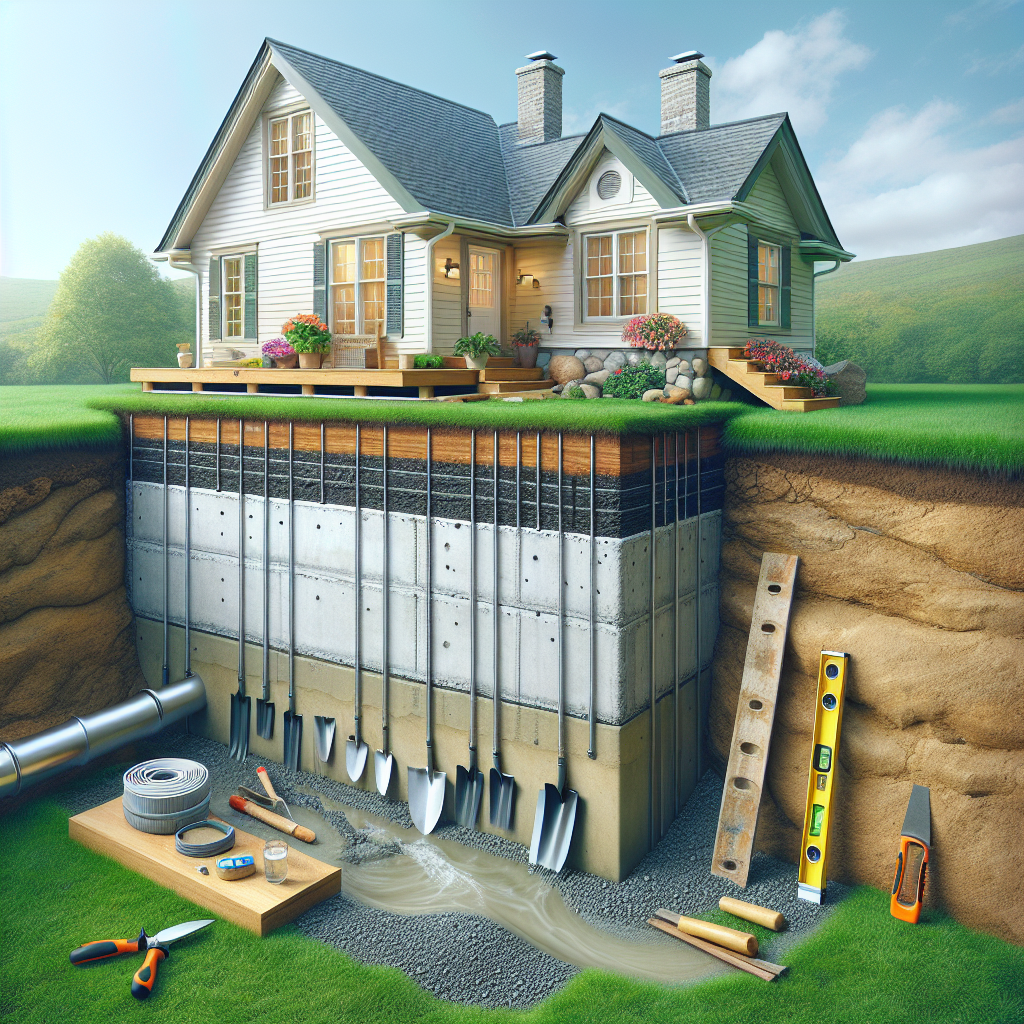Welcome to BuildNet, your go-to resource for understanding and maintaining the backbone of your home – the foundation. Whether you’re a new homeowner or have been in your residence for years, knowing the types of foundations and how to maintain them is crucial for ensuring the stability and safety of your home. In this comprehensive guide, we’ll walk you through the essentials of home foundations, provide detailed steps for regular inspections, and offer practical maintenance tips to help you avoid costly repairs.
Understanding Your Home’s Foundation: Types and Importance
Your home’s foundation serves as the main support structure, keeping everything above ground level, stable, and secure. The type of foundation your home has depends on several factors including geographic location, climate, and soil type. Common types of foundations include:
- Concrete Slab Foundations: A single layer of concrete poured directly on the ground; popular in warmer climates.
- Crawl Space Foundations: Allows for better air circulation and easy access to plumbing and electrical systems.
- Basement Foundations: Provides additional living or storage space and can help in colder climates by placing the foundation below the frost line.
Understanding the type of foundation you have is the first step in effective home maintenance.
Regular Foundation Inspection: Key Steps and What to Look For
Inspecting your foundation regularly is essential to catch issues before they escalate into major repairs. Here are some key steps and signs to look for during an inspection:
- Check for Cracks: Small cracks might be normal settling, but large or expanding cracks could indicate problems.
- Observe Water Drainage: Improper drainage can lead to water damage and weaken your foundation.
- Look for Uneven Floors: This could be a sign of foundation shifting or sinking.
Effective Foundation Maintenance Tips: Preventing Costly Repairs
Maintaining your foundation doesn’t have to be a daunting task. Simple practices like maintaining proper drainage and minimizing soil expansion can go a long way in preserving the integrity of your foundation. Stay tuned as we delve deeper into these preventive measures to keep your foundation in top shape, saving you potentially thousands in repairs.

If you’re ready to take your home improvement or construction project to the next level, we can help! Find trusted contractors on BuildNet, whether you’re looking for renovations, new builds, electrical work, plumbing, or anything in between. Our directory connects you with qualified professionals who can make your vision a reality.
Understanding Your Home’s Foundation: Types and Importance
Welcome to the foundational world of homes—quite literally! Whether you’re a new homeowner or just looking to brush up on some house-smarts, understanding your home’s foundation is crucial. Not only is it essential for the stability of your home, but knowing a bit more about it can also save you from future headaches. Let’s dive into the different types of foundations and their importance.
What is a Foundation?
A foundation is what supports your entire house; it’s the lower portion of the building structure that transfers its load to the soil beneath it. A strong foundation ensures durability and the structural integrity of your home. It also plays a key role in insulating against cold, keeping out moisture, and resisting movements of the earth around it.
Types of Foundations
Foundations come in various forms, each with its benefits and best use scenarios. Depending on geographical location, soil type, climate, and building size, the appropriate foundation type can vary. Here are the most common types:
1. Slab-on-Grade Foundation
A slab-on-grade foundation is a single layer of concrete, several inches thick, laid directly on the soil. This type of foundation is suitable for areas with a high water table or where frost heave is not a concern. It’s relatively inexpensive and quick to install, which makes it a popular choice in warm climates.
2. Crawl Space (Pier and Beam) Foundation
This foundation type features footings placed deep below the frost line and a crawl space under the house, usually about two feet high. The crawl space allows for easy access to plumbing and electrical systems, and because it’s elevated, it provides good protection from soil moisture—making it a great option for damp areas or regions with expansive soils.
3. Basement Foundation
Though more costly and complex to build, basement foundations offer extra living or storage space. They are typically built by excavating a space deeper than the frost line and then constructing walls and a floor from concrete. Basements are particularly common in cold climates because they are below the frost depth, which helps prevent them from being affected by freeze-thaw cycles.
Importance of a Proper Foundation
Now that you know a bit more about the types of foundations, let’s talk about why a proper foundation is so crucial:
Stability and Support
The primary purpose of a foundation is to hold up and support the entire structure of your home. A well-built foundation ensures that the building stays level and firm, even as the earth moves and seasonal changes occur.
Moisture Control
Without a proper foundation, water can enter your home, leading to mold growth, damaged belongings, and weakened structural materials. A foundation designed for your environment keeps moisture out and helps maintain the dryness of building materials.
Insulation
Apart from stability and moisture control, foundations also play a significant role in insulating your home. For example, basements provide an extra layer of insulation against cold weather, helping to keep your home warm during winter months.
Resale Value
A strong, well-maintained foundation can significantly increase your home’s resale value. Potential buyers often consider the condition of the foundation when evaluating a property, knowing that issues here can lead to monumental costs down the road.
Why Local Foundation Choices Matter
Choosing the right type of foundation not only depends on your budget and personal preference but also on the local environment. For instance, if you’re living in an area prone to earthquakes, choosing a foundation type that offers flexibility, like certain modern slab designs, can be crucial. Similarly, for areas with volatile soil types, a deep foundation could be necessary to reach stable strata beneath the ground.
Local building codes and regulations also play a significant role in the decision. These codes are designed based on local climate patterns, soil conditions, and geological data to ensure safety and durability. Consulting with a local contractor who understands these nuances can help you make the best choice for your home.
Understanding the foundation of your home is more than just knowing what lies beneath your feet. It’s about securing the longevity, safety, and comfort of your living space. So, don’t overlook the importance of getting it right—it’s what everything else is built upon!

Regular Foundation Inspection: Key Steps and What to Look For
Welcome to your go-to guide on foundation inspections! Whether you’re a seasoned homeowner or a newbie navigating the responsibilities of homeownership, understanding the ins and outs of foundation inspections is crucial. Not only does it ensure the safety and stability of your home, but it also helps in preventing those wallet-draining repairs down the line. So, grab your notepad, and let’s dive into the essentials of keeping your foundation in tip-top shape!
Why Regular Foundation Inspections are a Must
Think of your home’s foundation as its backbone; just as you’d care for your own health, your home’s structural integrity needs regular check-ups too. Inspections can highlight potential issues early on, avoiding extensive and expensive repairs later. Plus, they maintain your home’s value—very important if you plan to sell in the future.
How Often Should You Inspect Your Foundation?
Generally, it’s a good rule of thumb to schedule a professional foundation inspection annually. However, if you live in areas prone to extreme weather changes, or if your home has had foundation issues in the past, you might want to consider inspecting more frequently.
DIY Foundation Inspection: A Step-by-Step Guide
If hiring a professional every time is not within your budget, here’s how you can conduct a basic foundation inspection yourself:
Step 1: Inspect the Ground Surrounding Your Home
- Check the soil: The soil around your home should slope away to prevent water accumulation near the foundation. Water pooling can lead to serious foundation issues.
- Look for plant life: While plants can beautify your home, make sure trees are planted a safe distance away. Tree roots can grow underneath and disrupt the foundation.
Step 2: Check the Foundation Walls
- Look for cracks: Hairline cracks might be normal settling, but large, horizontal cracks can indicate serious stress on the foundation. Note any changes in crack width or new cracks.
- Signs of bulging or bowing: This can suggest that the earth around your home is expanding and contracting, putting pressure on the walls.
Step 3: Examine the Basement or Crawlspace
- Check for dampness: Moisture in these areas can be a sign of inadequate drainage around the foundation, potentially leading to bigger problems.
- Spot mold or mildew: Their presence often indicates higher than normal moisture levels which, again, can threaten the integrity of the foundation.
Step 4: Assess the Interior
- Doors and windows: Sticky doors or windows that won’t close properly can be a sign of foundation shifts.
- Uneven floors: Use a level to check for slopes in the floor, another potential indicator of foundational movement.
Professional Inspection: When to Call the Experts
While DIY checks are great for ongoing maintenance, certain signs require a professional’s touch. Here’s when you should definitely consider calling a foundation expert:
- Significant cracks: Any large or widening cracks should be examined by a professional.
- Water leaks: If your basement or crawlspace has persistent water issues despite your best efforts, it’s time to call in the pros.
- Structural issues: Any signs of structural damage, such as a tilting chimney or severe bowing of walls, need professional assessment.
Tips for Choosing a Foundation Inspection Professional
Finding the right expert for foundation inspections can be daunting. Here are a few tips to help you choose a reliable specialist:
- Check qualifications and licensing: Ensure the inspector has the necessary qualifications and adheres to local licensing requirements.
- Read reviews: Look up reviews or ask for references to gauge their reputation and reliability.
- Ask about their experience with local soil types: Every region has different environmental factors that affect foundations differently.
By following these steps, not only will you extend the life of your home’s foundation, but you’ll also gain peace of mind. Remember, when it comes to your home, being proactive is always better than reactive! So, keep an eye out, stay vigilant, and don’t hesitate to seek professional help when needed. Your home will thank you for it!
Effective Foundation Maintenance Tips: Preventing Costly Repairs
Hey there, savvy homeowner! Are you looking to keep your home’s foundation in tip-top shape? You’ve landed in the right place. Maintaining the foundation may not be the most glamorous part of homeownership, but it’s absolutely critical. Let’s dive into some proactive steps you can take to prevent costly repairs, because let’s face it, a solid foundation is key to a happy, healthy home!
Keep an Eye on Water Management
First things first, water is your foundation’s biggest enemy. Managing how water interacts with your foundation can go a long way in preventing structural issues. Here’s what you can do:
- Gutters and Downspouts: Ensure your gutters are clean and free of debris. The downspouts should direct water at least 5 feet away from your home’s foundation. Consider adding gutter guards to minimize maintenance.
- Slope: The ground around your home should slope away from the foundation to prevent water pooling. A good rule of thumb is a slope of 6 inches for the first 10 feet around the foundation.
- Drainage: Install a French drain system if you have serious concerns about water pooling. It’s an investment that can save you from bigger expenses down the road.
Monitor Cracks and Address Them Early
Not all cracks are created equal, but they all start small. Regularly checking for new cracks or changes in existing ones can be a game-changer. Here’s how to tackle them:
- Visual Inspection: Make it a habit to inspect your foundation walls and flooring every season. Look for cracks that are wider than 1/4-inch or growing.
- Early Intervention: For small cracks, use epoxy or urethane injections to seal them up before water seeps in and exacerbates the problem.
- Professional Help: If you notice large, zigzagging, or horizontal cracks, it’s time to call in the professionals. These could be signs of serious structural issues.
Maintain Soil Moisture Levels
Fluctuations in soil moisture levels can cause your foundation to heave or settle. To maintain a consistent moisture level:
- Watering Your Foundation: Yes, you read that right! During dry spells, consider using a soaker hose around the perimeter of your home to maintain moisture consistency in the soil.
- Avoid Over-watering: On the flip side, too much water can lead to problems as well. Ensure your watering schedule adapts to the current weather conditions.
Inspect and Repair the Plumbing Regularly
Leaks from plumbing can lead to significant foundation problems. Here’s what you need to keep in check:
- Regular Checks: Have a professional inspect your plumbing system annually. It’s especially important if your home is older or has a history of plumbing issues.
- Look for Signs: Keep an eye out for wet spots around floors and walls, or an unexpected increase in your water bill – these could be clues that not all is well underneath.
Be Mindful of Tree Placement
Trees can be a wonderful addition to your yard, but their roots can be formidable foes to your foundation. Here are a few tips:
- Distance: Plant large trees at least as far away from your home as their maximum root zone could extend.
- Root Barriers: Consider installing root barriers to keep roots from growing into your foundation, while still allowing trees to thrive.
Foundation-friendly Landscaping
Who says functional can’t be beautiful? Choose your landscaping elements wisely to enhance your foundation’s health:
- Gravel and Rocks: Use gravel or rock near the foundation for better drainage and less water retention.
- Plants: Select plants that require less water and have smaller root systems to minimize the impact on your foundation.
Remember, preventative maintenance is key when it comes to your home’s foundation. A little effort can prevent big problems, keeping your foundation strong and your home secure. Regular check-ups and being proactive about potential issues can save you a lot of time, stress, and money. So, roll up your sleeves and give your home the solid base it deserves!

What are the common types of home foundations?
Home foundations vary depending on climate, soil type, and construction methods. The most common types include slab-on-grade, crawl space, and basement foundations. Slab-on-grade is a single layer of concrete poured directly onto the soil, ideal for warmer climates. Crawl spaces elevate the home off the ground, preventing moisture issues and allowing easy access to wiring and plumbing. Basements provide additional living space and are common in colder regions where a deeper foundation is necessary to reach below the frost line.
Why is the foundation of a home so important?
The foundation supports the entire weight of your house, ensuring stability and structural integrity. It keeps your home level and prevents it from sinking into the soil. A strong foundation also helps to keep out moisture, insulate against cold, and resist movement caused by soil shifting or earthquakes. Ensuring your foundation is in good condition is crucial for the safety and longevity of your home.
How often should I inspect my home’s foundation?
It’s recommended to inspect your foundation at least once a year. However, if you live in an area with extreme weather conditions or have experienced recent seismic activity, more frequent inspections may be necessary. Regular checks help you catch issues early, potentially saving you from costly repairs down the line.
What should I look for during a foundation inspection?
During a foundation inspection, look for cracks in the walls or flooring, doors or windows that won’t close properly, and any signs of water damage. Uneven floors or bowed walls are also indicators of potential foundation issues. Paying attention to these signs can help you address problems before they escalate.
What are some effective maintenance tips for home foundations?
Maintaining your foundation involves keeping soil moisture levels consistent around your home, ensuring proper drainage, and preventing the growth of large tree roots near your foundation. Regularly cleaning gutters and downspouts to direct water away from your home and checking for plumbing leaks are also critical steps to prevent foundation damage.
How can I prevent costly repairs on my foundation?
Preventing costly repairs starts with routine maintenance and early detection of potential issues. Ensure that water drains away from your foundation, repair leaks promptly, and control the plant growth around your foundation perimeter. Additionally, consider consulting with a structural engineer or foundation specialist if you notice significant changes or have concerns about your foundation’s integrity.
Conclusion
Maintaining the foundation of your home is a crucial aspect of homeownership that should not be overlooked. Understanding the type of foundation your home has, performing regular inspections, and following through with routine maintenance can save you from facing hefty repair bills in the future. Remember, the signs of foundation issues such as cracks, difficulty in operating doors and windows, or uneven flooring should prompt you to take action.
If you’re unsure about the condition of your foundation or need professional advice, it’s always best to consult with a specialist. At BuildNet, we can connect you with experienced local contractors who can provide comprehensive inspections and expert repairs. Don’t hesitate to visit our website and contact a contractor for a free quote. Keeping your foundation in top shape protects your home and ensures it remains a safe and comfortable place for you and your family.







